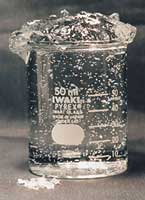|
|
|||||||
|
|
|||||||
|
|||||||
| | Web Japan >>| Trends in Japan >> | Science & Technology >> | Can Natto Save the Earth? | |
|
CAN NATTO SAVE THE EARTH? Sticky Food Good for More than Just Eating (March 4, 2004) Natto (fermented soybeans), a traditional Japanese food rich in protein and vitamin B, is becoming widely known as a health food. Though it is a bit difficult to eat because of its stickiness, it has been discovered that this stickiness may be able to play an important role in protecting the environment. Companies have begun producing and selling natto resin, thanks to a discovery by Hara Toshio, an associate professor at the Faculty of Agriculture of Kyushu University's Graduate School. Natto resin can absorb 5,000 times its weight in water, and this remarkable property is already being put to use in cosmetics and wrappings for food products. Ideas for the future include using natto resin in the reforestation of desert areas.
Excellent Absorbency and Flexibility Natto resin is 100% natural, and it boasts high absorbency and elasticity. It can hold roughly five times as much water as the material in paper diapers. Even after it exceeds its absorbent capacity, the resin turns into a jelly-like substance. Turning an eye to these impressive properties, Hara devised various ways to use this resin. The first was in trays for fish, meat, and other foods. When trays and other implements made with this resin are disposed of, they can be buried in the ground where they will break down naturally. When they are thrown away with household garbage, things made with natto resin will absorb the water and turn into jelly, protecting the surrounding area from pollution. And when natto resin is mixed with cattle dung, it will become gelatinous and will not freeze in the winter. This makes it much easier to produce fertilizer. In addition, mud dredged from the bottom of a dammed lake can be dried in the sun and then mixed with natto resin and seeds and rolled into pellets, from which the seeds can grow. Because the natto resin can absorb rainwater so well, these pellets can be scattered and will produce plants even in such inhospitable places as mountainsides and deserts. This technology offers the potential of killing two birds with one stone by providing a way to both dispose of sludge and halt desertification at the same time. Natto resin breaks down over time, so it is environmentally friendly and leaves behind no harmful substances.
Halting Desertification While Growing Food Hara advocates the use of natto resin as part of what he calls a "green recycling system." Pellets containing soybean seeds can be planted and grown in the desert and then harvested and made into natto resin, which can be used to grow more soybeans. By making deserts green and growing food at the same time, this plan appears to have no downside. Professor Hara is currently considering ways to make this a reality in the area around the Yellow River in China. Related Web SitesFaculty of Agriculture of Kyushu University's Graduate School Copyright (c) 2004 Web Japan. Edited by Japan Echo Inc. based on domestic Japanese news sources. Articles presented here are offered for reference purposes and do not necessarily represent the policy or views of the Japanese Government. |
GREEN PLASTIC (February 13, 2003) FULL OF BEANS (November 28, 2002) OUTWITTING GARBAGE (November 30, 2001) |
|
|



